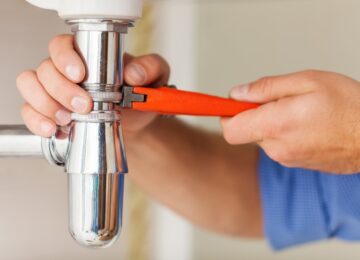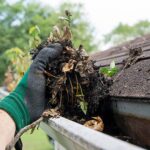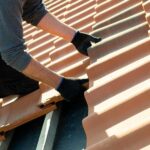Aging Plumbing Components
In Riverside, CA, where the climate can sometimes be harsh on plumbing systems, recognizing the signs of aging plumbing is crucial to maintaining your home’s efficiency and safety. Here’s what to look out for:
Signs of Aging Pipes
- Discoloration: If you notice that your water has a brown, yellow, or rusty hue, it could be a sign that your pipes are aging and beginning to corrode. Discolored water often indicates that there is rust or sediment build-up inside your pipes. This not only affects the quality of your water but can also lead to health concerns and further plumbing issues if not addressed promptly.
- Visible Corrosion: Check for visible signs of corrosion on exposed pipes, such as a greenish or brownish discoloration. Corroded pipes often appear pitted or flaking. In Riverside, where the hard water can exacerbate pipe corrosion, it’s important to regularly inspect your plumbing system. Corrosion weakens pipes and increases the risk of leaks or bursts.
- Frequent Leaks: Frequent leaks can be a major red flag that your plumbing system is showing signs of age. Leaks often occur when pipes become weakened over time. If you find yourself needing to repair leaks regularly, it’s a clear indicator that your plumbing may need upgrading. Leaks not only waste water but can also cause damage to your home’s structure, leading to more costly repairs.
Typical Lifespan of Plumbing Materials
- Copper Pipes: Copper pipes are known for their durability and can last between 50 to 70 years. However, in Riverside, CA, the lifespan may be shorter due to local water quality and environmental factors. If your home’s copper pipes are nearing this age range, it might be time to consider a replacement.
- PVC Pipes: PVC (polyvinyl chloride) pipes generally have a lifespan of around 25 to 40 years. They are resistant to corrosion and are a common choice for residential plumbing. However, if you’re experiencing issues with your PVC pipes and they are nearing the end of their expected lifespan, an upgrade could be beneficial.
- Galvanized Steel Pipes: Galvanized steel pipes, once a common choice, typically last around 20 to 50 years. These pipes are prone to rust and corrosion over time. If your home has galvanized pipes and they are showing signs of aging or frequent problems, it is wise to consider replacing them with more modern materials.
- Pex Pipes: PEX (cross-linked polyethylene) pipes are relatively new and can last up to 40 years. They are flexible and resistant to scale and chlorine. Although they are durable, regular inspections are still necessary to ensure they are in good condition.
Low Water Pressure
How Low Water Pressure Can Indicate Serious Plumbing Issues
- Pipe Corrosion: One of the primary causes of low water pressure is pipe corrosion. As pipes age, especially if they are made of metal like galvanized steel or copper, they can corrode and rust. This corrosion leads to a narrowing of the pipe’s diameter, reducing the flow of water. In Riverside, where hard water can accelerate pipe corrosion, it’s particularly important to monitor your pipes for signs of wear.
- Clogs and Blockages: Another common cause of low water pressure is clogs or blockages within the plumbing system. Over time, sediment, mineral deposits, and other debris can accumulate in pipes, restricting water flow. If you notice a significant drop in water pressure, especially in one area of your home, it could indicate that a clog or buildup is affecting your system’s performance.
- Pipe Leaks: Leaks can also contribute to reduced water pressure. When a pipe leaks, water is lost before it reaches the fixtures in your home, leading to diminished pressure. Leaks can occur due to pipe damage or faulty connections, and they often go unnoticed until they cause noticeable issues with water flow.
Steps to Diagnose if the Low Pressure is a Localized Issue or a Systemic Problem
- Check Multiple Fixtures: Start by testing the water pressure at different fixtures throughout your home. If low water pressure is limited to just one faucet or showerhead, the issue may be localized to that specific fixture. This could be due to a clogged aerator or a malfunctioning fixture. Clean or replace the affected fixture to see if the pressure improves.
- Inspect for Visible Leaks: Look for any signs of leaks around your home, such as damp spots, water stains, or pooling water. Leaks in visible areas can often be identified through these signs. If you find any leaks, they should be addressed promptly, as they can impact overall water pressure and lead to more significant issues if left unresolved.
- Test Water Pressure at the Main Supply: Use a pressure gauge to test the water pressure at the main supply valve. If the pressure is low at this point, the issue is likely systemic and may be related to the main supply line or the overall plumbing system. This could indicate problems such as corroded pipes, blockages in the main line, or issues with the water supply from the municipal source.
- Examine Your Water Meter: Check your water meter for any signs of unusual activity or fluctuations in water usage. A constant flow or unexpected increase in water usage can signal a hidden leak in your system, contributing to low water pressure.
- Consult a Professional: If you’re unable to determine the cause of low water pressure through these steps, it’s wise to consult a professional plumber. They have the tools and expertise to perform a more thorough diagnosis, including pipe inspections with cameras, water pressure testing, and detailed analysis of your plumbing system.
Frequent Clogs and Slow Drains
- Deteriorating Pipe Conditions: Persistent clogs and slow drains often signal that your pipes are in poor condition. Over time, pipes can accumulate debris, grease, hair, and other materials that lead to blockages. If these clogs become frequent or seem unmanageable, it could indicate that your pipes are deteriorating. Old pipes, especially those made from materials like galvanized steel or clay, can become corroded, cracked, or otherwise compromised, making them more susceptible to clogs.
- Pipe Damage: Constant clogs can also be a sign of physical damage to your pipes. Pipes that are cracked, bent, or improperly installed may not handle water flow as efficiently, leading to frequent blockages. In some cases, damaged pipes can create pockets where debris accumulates, exacerbating the clogging issue. Upgrading to newer, more durable pipes can help mitigate these problems and improve overall drainage.
Impact of Hard Water in Riverside and Its Effects on Plumbing Efficiency
- Hard Water Deposits: Riverside, CA, is known for its hard water, which contains high levels of calcium and magnesium. Hard water can have a significant impact on your plumbing system. Over time, these minerals can deposit onto the inside walls of your pipes, leading to a condition known as mineral scaling. This scaling reduces the internal diameter of your pipes, which impedes water flow and can contribute to frequent clogs and slow drainage.
- Impact on Fixtures and Appliances: Hard water can also affect your home’s fixtures and appliances. Mineral deposits from hard water can accumulate in faucets, showerheads, and appliances like dishwashers and water heaters. This buildup not only decreases the efficiency of these fixtures but can also lead to blockages and malfunctions. Regular maintenance and upgrades to fixtures and appliances can help manage the impact of hard water.
- Reducing Hard Water Effects: Installing a water softenercan help reduce the effects of hard water on your plumbing system. By removing excess minerals from your water supply, a water softener can help prevent scaling and reduce the frequency of clogs and slow drains. In Riverside, incorporating a water softening system into your plumbing upgrade can significantly enhance the performance and longevity of your pipes and fixtures.
Water Discoloration
What Rusty or Discolored Water Means for Your Home’s Plumbing
- Corroded Pipes: Rusty or discolored water often signals that your pipes are corroding. As pipes age, especially those made from metals like iron or steel, they can develop rust and corrosion. This corrosion can cause the pipes to deteriorate, leading to the release of rust particles into the water supply. In Riverside, where hard water can exacerbate corrosion, the risk of experiencing discolored water increases. If you notice a reddish-brown tint in your water, it’s a clear indication that your pipes may be compromised and in need of replacement.
- Sediment Buildup: Discolored water can also result from sediment buildup in your pipes. Over time, sediment from water can accumulate and dislodge, leading to cloudy or murky water. This sediment buildup can reduce the efficiency of your plumbing system and contribute to further issues like clogs and reduced water flow. Upgrading to modern, corrosion-resistant pipes can help prevent sediment-related problems and ensure a cleaner, more reliable water supply.
Potential Health Hazards Associated with Corroded Pipes Releasing Metals into Water
- Health Risks from Rust and Corrosion: Corroded pipes can release harmful metals such as lead and iron into your drinking water. Lead, in particular, poses significant health risks, especially for children and pregnant women. Exposure to lead can cause developmental issues in children and increase the risk of pregnancy complications. Iron, while less toxic, can still affect water quality and contribute to health concerns if consumed in large quantities.
- Contaminants and Bacteria: Corroded pipes can also harbor bacteria and other contaminants. Rust and corrosion can create an environment conducive to bacterial growth, potentially leading to waterborne diseases. Regularly discolored water could indicate that your plumbing system is not only affecting water appearance but also its safety. Ensuring that your pipes are in good condition and replacing outdated or damaged plumbing is crucial for maintaining clean and safe water.
Increased Water Bills
Unexpected Spikes in Water Bills
- Hidden Leaks: A sudden increase in water bills is often a sign of hidden leaks within your plumbing system. Leaks can occur in various parts of your plumbing network, including pipes buried in walls, underground, or within the slab of your home. These leaks can be slow and subtle, causing water to seep away without obvious signs of damage. As a result, you may notice higher water usage on your bills without any visible indication of a problem.
- Plumbing Inefficiencies: Inefficiencies in your plumbing system can also lead to higher water bills. Aging fixtures, outdated appliances, or poorly installed pipes can result in increased water consumption. For example, old toilets and faucets may not function as efficiently as newer models, leading to higher water usage. Upgrading these components can help reduce water consumption and lower your bills.
Methods for Tracking Down Unseen Leaks
- Check Your Water Meter: Begin by monitoring your water meter. Turn off all water sources in your home, including faucets and appliances, and check the meter. If the meter continues to move or show water usage even when all fixtures are off, it could indicate a hidden leak. Record the meter reading and compare it over a few hours to detect any changes.
- Inspect Your Property for Visible Signs: Look for any visible signs of leaks around your property. Check for damp spots, mold growth, water stains, or pooling water in areas like your yard or basement. While visible leaks can provide clues, hidden leaks may not be immediately apparent.
- Use Leak Detection Tools: Professional plumbers often use specialized tools for leak detection. Acoustic leak detectors can pick up the sound of water escaping from pipes, while infrared cameras can identify temperature changes caused by leaks behind walls or underground. If you suspect a hidden leak, a professional can utilize these tools to accurately locate the problem.
- Conduct a Dye Test: For leaks in toilets or fixtures, a dye test can be effective. Add a few drops of food coloring to the toilet tank and wait for about 30 minutes without flushing. If the colored water appears in the bowl, it indicates a leak in the tank’s flapper or other components.
- Consult a Professional Plumber: If you’re unable to locate the source of increased water usage or suspect a hidden leak, it’s best to consult a professional plumber. They have the expertise and equipment to perform a thorough inspection, identify leaks or inefficiencies, and recommend the necessary repairs or upgrades.
Strange Noises in the Plumbing System
Causes of Banging, Whistling, or Gurgling Sounds in Pipes
- Banging (Water Hammer): Banging or knocking noises, often referred to as “water hammer,” occur when water flowing through your pipes is abruptly stopped by a valve or faucet. This sudden stoppage creates a shock wave that causes the pipes to bang against the walls or supports. Water hammer can be caused by fast-closing valves, improperly secured pipes, or a lack of air chambers designed to absorb the shock. Over time, these repeated impacts can damage your pipes and fittings.
- Whistling (High Water Pressure or Pipe Obstructions): Whistling or high-pitched noises typically indicate issues with water pressure or pipe obstructions. If the water pressure is too high, it can cause the water to flow through the pipes with excessive force, creating a whistling sound. Similarly, obstructions or partial blockages in the pipes can lead to turbulent water flow, resulting in whistling noises. Both conditions can lead to increased stress on your plumbing system and potential damage.
- Gurgling (Ventilation or Drainage Issues): Gurgling noises are often a sign of ventilation or drainage issues. When you hear gurgling sounds coming from your drains or toilets, it may indicate that the plumbing vents are blocked or that there is a problem with the drainage system. Blocked vents can create negative pressure in the pipes, causing air to escape through the drains and produce gurgling sounds. Alternatively, gurgling can occur when there is a partial blockage in the drainage system, affecting the flow of water and air.
What These Sounds Can Indicate
- Water Hammer: Persistent water hammer may indicate that your plumbing system is not properly designed or that components are aging. Installing water hammer arrestors or upgrading to modern plumbing materials can help mitigate these issues and prevent further damage to your pipes.
- Whistling: If whistling noises are due to high water pressure, it may be necessary to install a pressure regulator to control the pressure within safe limits. If the issue is caused by obstructions, a professional plumber can perform a thorough inspection and cleaning of the pipes to remove any blockages and restore proper flow.
- Gurgling: Gurgling sounds can signal a need for ventilation system upgrades or repairs. Ensuring that your plumbing vents are clear and properly functioning is essential for maintaining good drainage and preventing air from escaping through your fixtures. If drainage issues persist, it may be necessary to inspect and upgrade the drainage system to address any blockages or inefficiencies.
Water Stains and Damage
Identifying Water Stains on Walls, Ceilings, or Floors
- Wall Stains: Water stains on walls often indicate leaks in the plumbing pipes running within or behind the wall. These stains can appear as discoloration, bubbling paint, or peeling wallpaper. Common sources of wall stains include leaky pipes, faulty joints, or damaged fixtures. If you notice stains on your walls, it’s essential to investigate the source of the leak to prevent further damage.
- Ceiling Stains: Water stains on ceilings usually point to leaks from plumbing pipes located above the ceiling or issues with the roof. These stains can manifest as dark, discolored patches and may be accompanied by sagging or peeling paint. Ceiling stains are often associated with leaks from bathrooms or kitchens located on the upper floors of your home. Identifying and repairing these leaks promptly is vital to avoid potential structural damage.
- Floor Stains: Water stains on floors, especially in areas such as basements or near appliances, can indicate leaks from pipes or appliances. Stains may appear as darkened patches or water spots and can sometimes be accompanied by mold growth or musty odors. Common causes include leaking water heaters, washing machines, or damaged pipes. Addressing these issues quickly can help prevent water damage and mold growth.
Addressing These Issues Promptly to Prevent Structural Damage
- Preventing Mold Growth: Prolonged exposure to moisture from leaks can lead to mold and mildew growth. Mold not only affects indoor air quality but can also cause health issues such as respiratory problems and allergic reactions. Addressing water stains and leaks promptly can help prevent mold development and protect the health of your household.
- Avoiding Structural Damage: Water damage can weaken the structural integrity of your home. Continued exposure to moisture can cause wood rot, damage to drywall, and deterioration of insulation. This structural damage can lead to costly repairs and compromise the safety of your home. Promptly repairing leaks and addressing water stains can help prevent extensive damage and maintain the structural stability of your home.
- Protecting Personal Property: Water stains and leaks can also damage personal property such as furniture, electronics, and valuable documents. By addressing plumbing issues early, you can protect your belongings from water-related damage and reduce the risk of having to replace or repair personal items.










